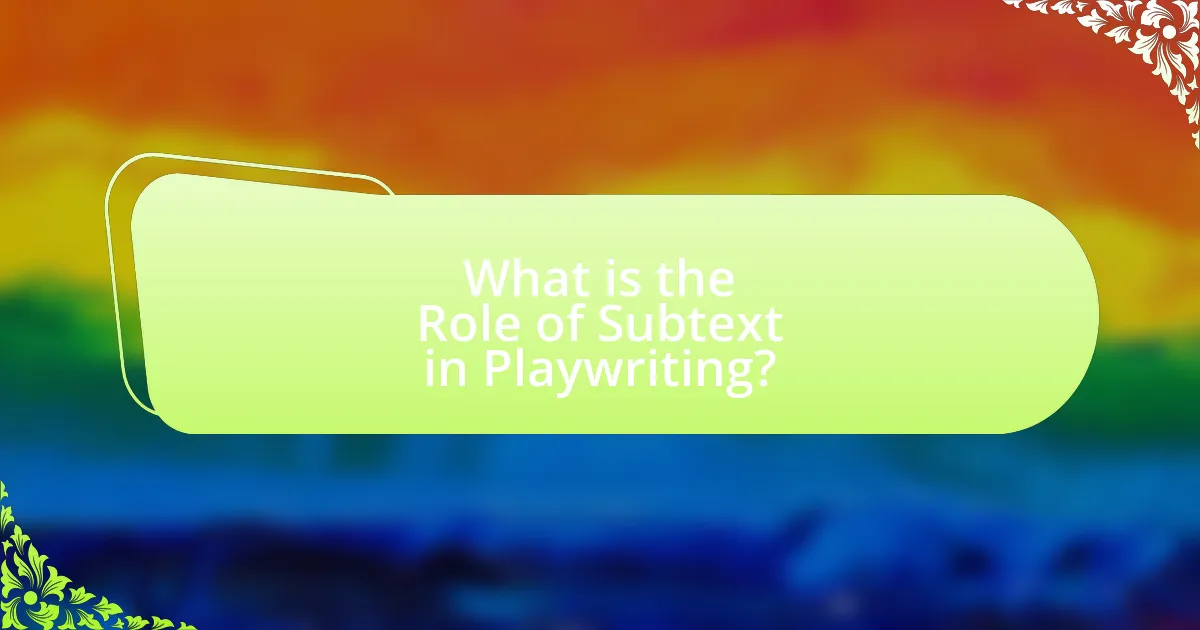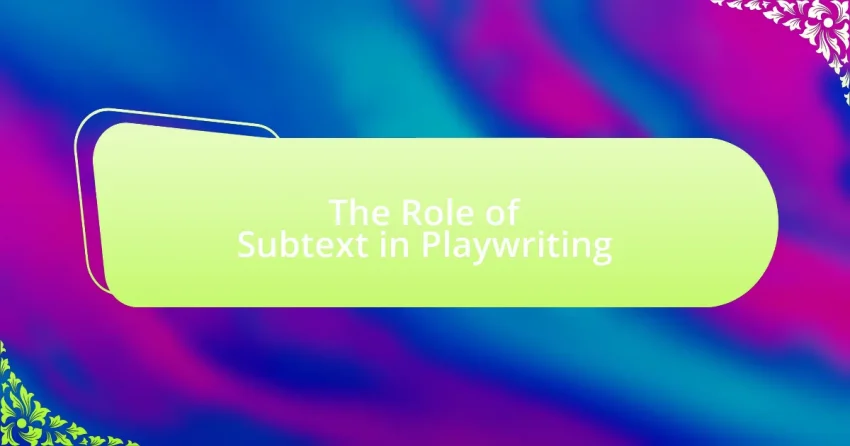The article examines the critical role of subtext in playwriting, highlighting its function as an underlying layer of meaning that enhances character interactions and plot development. It differentiates subtext from dialogue, emphasizing how it conveys emotions and motivations without explicit statements. Key elements defining subtext, such as underlying themes and emotional undertones, are discussed, along with its importance for character development and audience engagement. The article also explores various types of subtext, techniques for effective incorporation, and best practices for playwrights to balance subtext with overt dialogue, ultimately illustrating how subtext enriches narrative complexity and viewer interpretation.

What is the Role of Subtext in Playwriting?
Subtext in playwriting serves as an underlying layer of meaning that enhances character interactions and plot development. It allows playwrights to convey emotions, motivations, and conflicts without explicitly stating them, creating a richer narrative experience. For instance, in Tennessee Williams’ “A Streetcar Named Desire,” the subtext in the dialogue reveals the characters’ hidden desires and tensions, contributing to the play’s dramatic impact. This technique engages the audience, prompting them to read between the lines and interpret the deeper significance of the characters’ words and actions.
How does subtext differ from dialogue in playwriting?
Subtext differs from dialogue in playwriting in that subtext refers to the underlying meaning or emotions that are not explicitly stated, while dialogue consists of the spoken words between characters. Subtext enriches the narrative by conveying deeper themes and character motivations, often revealing what characters truly feel or think without saying it outright. For example, a character may say, “I’m fine,” while the subtext indicates they are actually upset, creating tension and complexity in the scene. This distinction is crucial for effective storytelling, as it allows audiences to engage with the characters on a more profound level, interpreting the unsaid elements that drive the plot forward.
What are the key elements that define subtext?
The key elements that define subtext include underlying themes, character motivations, and emotional undertones. Underlying themes refer to the deeper meanings and messages that are not explicitly stated but are conveyed through dialogue and action. Character motivations reveal what drives characters beyond their spoken words, often indicating desires or fears that influence their behavior. Emotional undertones encompass the feelings and moods that characters express indirectly, allowing audiences to perceive tension, conflict, or intimacy without overt declarations. These elements work together to create a richer narrative experience, engaging the audience’s interpretation and emotional response.
Why is subtext important for character development?
Subtext is crucial for character development because it reveals the underlying motivations, emotions, and conflicts that drive a character’s actions. By incorporating subtext, playwrights can create multi-dimensional characters whose true intentions may not be explicitly stated, allowing for deeper audience engagement and interpretation. For instance, a character may express anger while actually feeling fear, showcasing the complexity of human emotions. This layered communication enriches the narrative, making characters more relatable and realistic, as real-life interactions often involve unspoken feelings and thoughts.
What are the various types of subtext in plays?
The various types of subtext in plays include emotional subtext, social subtext, and thematic subtext. Emotional subtext conveys characters’ true feelings that are not explicitly stated, often revealing deeper motivations and conflicts. Social subtext reflects the societal norms and power dynamics at play, influencing character interactions and relationships. Thematic subtext encompasses the underlying messages or themes that the playwright intends to communicate, often requiring audience interpretation. Each type of subtext enriches the narrative, allowing for a more nuanced understanding of character and plot dynamics.
How does emotional subtext enhance a scene?
Emotional subtext enhances a scene by adding depth and complexity to characters’ interactions, allowing audiences to grasp underlying feelings and motivations that are not explicitly stated. This layer of meaning creates tension and engagement, as viewers interpret the unsaid emotions, which can lead to a more immersive experience. For instance, in Arthur Miller’s “Death of a Salesman,” Willy Loman’s unspoken despair and longing for success resonate through his dialogue and actions, enriching the narrative and evoking empathy from the audience. This demonstrates that emotional subtext is crucial for conveying the intricacies of human relationships and enhancing the overall impact of a scene.
What role does situational subtext play in plot development?
Situational subtext plays a crucial role in plot development by adding depth and complexity to character interactions and motivations. It allows audiences to infer underlying themes and tensions that are not explicitly stated, enriching the narrative. For example, in Arthur Miller’s “Death of a Salesman,” the subtext reveals Willy Loman’s internal struggles and societal pressures, which drive the plot forward and shape character relationships. This layered communication enhances emotional engagement and drives the audience’s understanding of the characters’ true intentions, ultimately influencing the trajectory of the plot.
How can playwrights effectively incorporate subtext?
Playwrights can effectively incorporate subtext by using dialogue that implies deeper meanings and emotions without stating them explicitly. This technique allows characters to convey their true feelings and intentions through their words, actions, and interactions, creating layers of meaning that engage the audience. For example, a character may express concern for another’s well-being while subtly revealing their own insecurities or desires, thus enriching the narrative. The use of subtext is supported by the works of playwrights like Tennessee Williams and Harold Pinter, who masterfully employed this technique to enhance character development and thematic depth in their plays.
What techniques can be used to create subtext in dialogue?
Techniques to create subtext in dialogue include using irony, implication, and character contradictions. Irony allows characters to say one thing while meaning another, creating layers of meaning. Implication involves suggesting ideas without stating them directly, prompting the audience to read between the lines. Character contradictions, where a character’s words conflict with their actions or emotions, reveal deeper truths about their motivations. These techniques enhance the richness of dialogue, allowing for a more nuanced exploration of themes and character relationships.
How can stage directions contribute to subtext?
Stage directions contribute to subtext by providing non-verbal cues that reveal characters’ emotions, intentions, and relationships beyond the spoken dialogue. For instance, a character’s hesitation to enter a room can indicate fear or conflict, while a sudden movement towards another character may suggest attraction or aggression. These actions, when interpreted alongside the dialogue, create layers of meaning that enhance the audience’s understanding of the characters’ true feelings and motivations. Research in theater studies highlights that effective stage directions can significantly deepen the narrative by allowing actors to embody subtext, thus enriching the overall performance and audience experience.

Why is Subtext Essential for Audience Engagement?
Subtext is essential for audience engagement because it adds depth and complexity to characters and narratives, allowing viewers to interpret and connect with the material on a more profound level. When subtext is effectively utilized, it creates layers of meaning that encourage audiences to think critically and emotionally about the story, fostering a more immersive experience. Research indicates that audiences are more likely to remain engaged when they can uncover hidden meanings and motivations, as demonstrated in studies on narrative comprehension, which show that deeper engagement leads to greater emotional investment in the characters and plot.
How does subtext influence audience interpretation?
Subtext significantly influences audience interpretation by providing deeper meanings and emotional layers beyond the explicit dialogue. This implicit communication allows audiences to engage with the material on a more profound level, as they decipher the underlying motivations and tensions between characters. For instance, in Arthur Miller’s “Death of a Salesman,” Willy Loman’s statements about success carry subtext that reveals his insecurities and societal pressures, prompting audiences to reflect on themes of the American Dream and personal failure. This layered complexity enhances the overall experience, as viewers are encouraged to read between the lines and form their interpretations based on the subtext presented.
What are the psychological effects of subtext on viewers?
Subtext significantly influences viewers’ psychological engagement by creating deeper emotional connections and enhancing interpretation. When subtext is present, it allows viewers to read between the lines, fostering a sense of intrigue and personal investment in the narrative. Research indicates that subtext can evoke a range of emotions, including empathy and tension, as audiences decipher underlying meanings and motivations of characters. For instance, a study published in the Journal of Communication found that narratives rich in subtext lead to increased viewer satisfaction and emotional resonance, as they encourage active participation in the storytelling process. This engagement not only enhances the overall viewing experience but also promotes critical thinking and reflection on the themes presented.
How can subtext create tension and suspense in a play?
Subtext creates tension and suspense in a play by conveying underlying emotions and conflicts that are not explicitly stated. This implicit communication allows characters to express hidden motives, fears, or desires, which can lead to dramatic irony when the audience understands more than the characters do. For example, in Arthur Miller’s “Death of a Salesman,” Willy Loman’s unspoken regrets and aspirations create a palpable tension as the audience anticipates the consequences of his actions. The contrast between what is said and what is meant heightens emotional stakes, keeping the audience engaged and on edge.
What are the challenges of writing subtext?
The challenges of writing subtext include the difficulty of conveying deeper meanings without explicit dialogue and the risk of misinterpretation by the audience. Writers must balance subtlety with clarity, ensuring that the subtext enhances the narrative rather than confuses it. Additionally, crafting effective subtext requires a deep understanding of character motivations and relationships, as well as the ability to weave these elements seamlessly into the dialogue and action. This complexity can lead to inconsistencies if not carefully managed, making it essential for playwrights to refine their skills in this area through practice and feedback.
How can ambiguity in subtext lead to misinterpretation?
Ambiguity in subtext can lead to misinterpretation by creating multiple possible meanings that confuse the audience. When subtext is not clearly defined, characters’ intentions and emotions may be perceived differently, resulting in varied interpretations of the narrative. For instance, a character’s ambiguous dialogue might suggest both affection and hostility, leading viewers to draw conflicting conclusions about relationships and motivations. This phenomenon is supported by research in communication theory, which indicates that unclear messages can result in diverse interpretations based on individual perspectives and experiences.
What strategies can playwrights use to avoid confusion in subtext?
Playwrights can avoid confusion in subtext by employing clear character motivations and consistent thematic elements. By ensuring that each character’s desires and intentions are well-defined, playwrights create a framework that guides the audience’s understanding of underlying meanings. For instance, in Arthur Miller’s “Death of a Salesman,” Willy Loman’s pursuit of the American Dream serves as a consistent subtext that informs his actions and interactions, making the underlying themes of failure and disillusionment clear. Additionally, using dialogue that aligns with the established subtext helps reinforce the intended meanings without ambiguity. This approach allows audiences to grasp the nuances without misinterpretation, thereby enhancing the overall impact of the play.

What are the Best Practices for Using Subtext in Playwriting?
The best practices for using subtext in playwriting include creating layered characters, utilizing dialogue that hints at deeper meanings, and ensuring that actions contradict spoken words. Layered characters allow for complexity, making their motivations and desires more nuanced, which enhances subtext. Dialogue should be crafted to suggest underlying emotions or conflicts without stating them outright, encouraging the audience to read between the lines. Additionally, when characters’ actions contradict their words, it creates tension and intrigue, prompting the audience to explore the subtext further. These practices are supported by the works of playwrights like Tennessee Williams and Harold Pinter, who effectively employed subtext to convey complex themes and emotions in their plays.
How can playwrights balance subtext with overt dialogue?
Playwrights can balance subtext with overt dialogue by strategically layering meaning within conversations while ensuring clarity in character intentions. This involves crafting dialogue that appears straightforward but carries deeper implications, allowing characters to express their true feelings indirectly. For instance, in Arthur Miller’s “Death of a Salesman,” Willy Loman’s overt statements about success mask his insecurities and failures, creating a rich subtext that enhances the audience’s understanding of his character. By using techniques such as irony, metaphor, and character contradictions, playwrights can create a dynamic interplay between what is said and what is meant, thus enriching the narrative without overwhelming the audience with complexity.
What are some examples of successful subtext in well-known plays?
Successful subtext in well-known plays includes the use of underlying themes and unspoken tensions that enhance the narrative. In Arthur Miller’s “Death of a Salesman,” Willy Loman’s obsession with success reflects societal pressures and personal failure, revealing deeper issues of identity and disillusionment. Tennessee Williams’ “A Streetcar Named Desire” employs subtext through Blanche DuBois’s fragile mental state, which is hinted at through her interactions and dialogue, illustrating themes of desire and decay. In Shakespeare’s “Hamlet,” the subtext of madness and revenge is conveyed through Hamlet’s soliloquies, which reveal his internal conflict and moral dilemmas. These examples demonstrate how subtext enriches character development and thematic depth in dramatic literature.
What tips can help new playwrights master subtext?
New playwrights can master subtext by focusing on character motivations, using dialogue that implies rather than states, and incorporating actions that reveal underlying emotions. Understanding that subtext is the unspoken layer of meaning allows playwrights to create depth in their characters and scenes. For instance, a character’s reluctance to directly express feelings can be shown through body language or indirect dialogue, which conveys their true emotions without explicit statements. This technique is supported by the principles of dramatic writing, where the tension between what is said and what is meant creates engagement and intrigue for the audience.
How can feedback from readings improve subtext in a script?
Feedback from readings can enhance subtext in a script by providing insights into audience perceptions and emotional responses. When actors and readers engage with the material, they often highlight areas where the underlying themes or character motivations may not be clear, allowing the writer to refine dialogue and actions to better convey hidden meanings. For instance, a reading may reveal that a character’s intentions are misinterpreted, prompting the writer to adjust the script to clarify subtext without overtly stating it. This iterative process of feedback ensures that the subtext resonates effectively, as evidenced by successful playwrights who frequently utilize readings to gauge audience reactions and make necessary adjustments, thereby enriching the overall narrative depth.
What exercises can help develop a writer’s ability to create subtext?
Exercises that can help develop a writer’s ability to create subtext include writing dialogue with hidden meanings, practicing character backstory development, and analyzing existing works for subtextual elements. Writing dialogue that conveys emotions or intentions indirectly encourages writers to think beyond explicit statements, fostering a deeper understanding of how subtext operates. Developing character backstories allows writers to embed motivations and conflicts that inform subtext, enriching the narrative. Analyzing plays or scripts known for their subtext, such as Tennessee Williams’ “A Streetcar Named Desire,” reveals how subtext can enhance character dynamics and thematic depth, providing concrete examples for writers to emulate.
